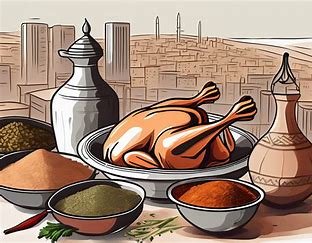The cuisine of the Middle East: A culinary journey
Middle Eastern cuisine is a rich tapestry of flavors, ingredients, and traditions, reflecting the diverse cultures and histories of the region. Embarking on a culinary journey through the Middle East offers a delightful exploration of dishes that are both aromatic and flavorful.

1. Mezze: A Feast of Small Dishes
- Hummus: A creamy dip made from blended chickpeas, tahini, lemon juice, and garlic. Often enjoyed with pita bread.
- Baba Ghanoush: A smoky eggplant dip mixed with tahini, garlic, and lemon juice.
- Tabbouleh: A refreshing salad made with bulgur wheat, parsley, tomatoes, mint, and lemon juice.
- Falafel: Deep-fried balls or patties made from ground chickpeas or fava beans, seasoned with herbs and spices.
2. Grilled and Roasted Meats
- Shawarma: Thinly sliced marinated meat (usually lamb, chicken, or beef) roasted on a vertical spit and served in a pita or flatbread with vegetables and sauces.
- Kebabs: Skewers of marinated meat (such as lamb, chicken, or beef) grilled to perfection. Popular variations include Shish Kebab and Kofta Kebab.
- Lamb Kofta: Ground lamb mixed with spices, onions, and herbs, shaped into patties or meatballs, and grilled.
3. Hearty and Flavorful Stews
- Tagine: A slow-cooked stew originating from North Africa, often made with lamb, chicken, or fish, and cooked with vegetables, dried fruits, and aromatic spices in a clay pot called a tagine.
- Mansaf: A traditional Jordanian dish featuring lamb cooked in a fermented yogurt sauce and served over rice or bulgur wheat.
- Khoresh: A Persian stew made with meat, vegetables, and a variety of spices. Popular variations include Khoresh-e Ghormeh Sabzi (herb stew) and Khoresh-e Fesenjan (pomegranate and walnut stew).
4. Breads and Grains
- Pita Bread: A soft, round flatbread that can be split open to form a pocket. Perfect for dipping, stuffing, or as a base for sandwiches.
- Lavash: A thin, soft flatbread common in Armenia, Iran, and Turkey.
- Couscous: Small steamed balls of crushed durum wheat semolina, often served as a side dish or base for stews and tagines.
- Rice Pilaf: Fragrant rice cooked with spices, nuts, and dried fruits. Variations include Persian Zereshk Polo (rice with barberries) and Lebanese Riz Bi Sharieh (rice with vermicelli).
5. Sweet Treats and Desserts
- Baklava: Layers of filo pastry filled with chopped nuts and sweetened with honey or syrup.
- Kanafeh: A dessert made from thin noodle-like pastry soaked in syrup and layered with cheese or nuts.
- Ma’amoul: Shortbread-like cookies filled with dates, nuts, or figs, often enjoyed during religious holidays.
- Turkish Delight (Lokum): Gelatinous cubes flavored with rosewater, lemon, or other ingredients, and dusted with powdered sugar.
6. Drinks and Beverages
- Turkish Coffee: A strong, unfiltered coffee served in small cups, often enjoyed with a piece of Turkish delight.
- Mint Tea: Fresh mint leaves brewed with green or black tea, sweetened with sugar. A popular drink in Morocco and the Maghreb region.
- Ayran: A refreshing yogurt-based drink mixed with water and salt, commonly enjoyed in Turkey and surrounding countries.
7. Spices and Herbs
- Sumac: A tangy red spice made from ground sumac berries, often used to add a lemony flavor to dishes.
- Za’atar: A blend of dried thyme, oregano, marjoram, sesame seeds, and sumac, used as a seasoning or mixed with olive oil to spread on bread.
- Cardamom: A fragrant spice used in both savory and sweet dishes, adding a warm, aromatic flavor.
Conclusion:
Middle Eastern cuisine is a celebration of rich flavors, vibrant colors, and diverse culinary traditions. From the small plates of mezze to the hearty stews and aromatic breads, each dish tells a story of the region’s history and culture. Exploring Middle Eastern cuisine is a journey that delights the senses and offers a deeper appreciation for the art of cooking.
